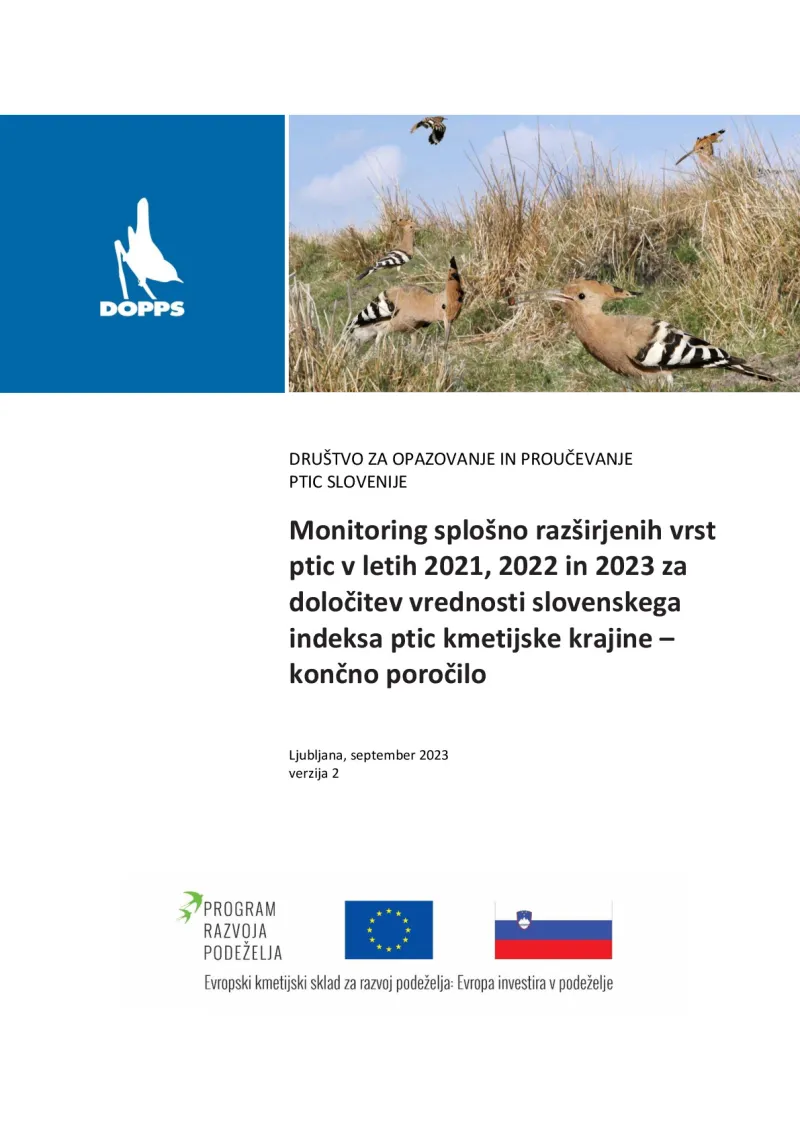Rapport final pour la détermination de l'indice des oiseaux des zones agricoles slovènes
Le rapport examine les résultats du suivi des espèces d'oiseaux communs entre 2008 et 2023, qui ont été utilisés pour déterminer l'indice des oiseaux des zones agricoles slovènes.
- Slovenia
- 2014-2022
- Environmental impacts


L'indice des oiseaux des zones agricoles est l'un des indicateurs de l'état de la biodiversité et de l'impact de la politique agricole dans le programme de développement rural (PDR) de la République de Slovénie pour la période 2014-2020 et dans le plan stratégique slovène relevant la PAC 2023-2027.
Ce rapport présente les résultats du suivi des espèces d'oiseaux communs utilisés pour déterminer l'indice des oiseaux des zones agricoles slovènes de 2008 à 2023. Il résume les principaux résultats du suivi et les résultats du recensement des espèces cibles pour chaque année. Le rapport fournit également une brève interprétation professionnelle des résultats du recensement, y compris le degré de fiabilité de l'estimation numérique et la conformité avec le protocole de recensement. La méthode de terrain est un inventaire standard par transects en deux bandes.
L'analyse des indices et des tendances des espèces a été réalisée à l'aide du module rtrim du programme. L'analyse des données rtrim utilise des modèles basés sur la régression de Poisson. La tendance totale multiplicative pour chaque espèce d'oiseau est classée par le programme sur la base de critères de pente et d'intervalle de confiance. L'indicateur (indice composite) a été calculé comme la moyenne géométrique des indices des types d'indicateurs.
La tendance de l'indice composite, son erreur type annuelle et les différences entre les tendances des groupes d'espèces ont été calculées à l'aide d'une simulation de Monte Carlo. Afin de comparer les tendances, les espèces ont été divisées en espèces généralistes et espèces des zones agricoles. Ces dernières ont été subdivisées en espèces des prairies et espèces non prairiales, ainsi qu'en espèces migratrices et non migratrices.
Selon les tendances calculées, les espèces indicatrices pour la période 2008-2023 sont classées en quatre groupes : forte diminution (2) : alouette des champs, tourterelle des bois ; diminution modérée (15) : bruant zizi, étourneau sansonnet, moineau friquet, alouette des bois, rossignol philomèle, cochevis huppé, bruant jaune, tarier pâtre, fauvette grisette, vanneau huppé, serin cini, linotte mélodieuse, pipit des arbres, pipit des arbres, rousserolle verderolle, tarier des prés ; stable (4) : pic vert, jynx, bruant proyer, pie-grièche écorcheur ; augmentation modérée (8) : pigeon ramier, huppe fasciée, pigeon biset, chardonneret élégant, rougequeue à front blanc, bergeronnette printanière, hirondelle rustique, faucon crécerelle.
L'indice des oiseaux des zones agricoles slovènes pour 2023 est de 75,7 %, soit 2,1 % de plus qu'en 2022. L'indice est stable depuis neuf ans, mais il convient d'interpréter cette tendance avec prudence. Les tendances à court terme peuvent être le résultat des conditions météorologiques et climatiques (hivers exceptionnellement doux), des conditions dans les zones d'hivernage (chasse illégale) et d'autres facteurs. Nous pourrions considérer cette tendance (surtout si elle se poursuit dans les années à venir) comme un tournant positif vers l'amélioration de la biodiversité des zones agricoles. La tendance générale pour la période 2008-2023 reste toutefois une baisse modérée et montre une diminution substantielle de la population. Le résultat actuel n'indique pas nécessairement une meilleure tendance à long terme. Les mesures agroenvironnementales nationales (conservation de la nature et agriculture biologique) ont certes un impact positif sur l'indice des oiseaux des zones agricoles, mais celui-ci n'est pas suffisamment fort.
Author(s)
Dr. Primož Kmecl, Matej Gamsar, dr. Tanja Šumrada